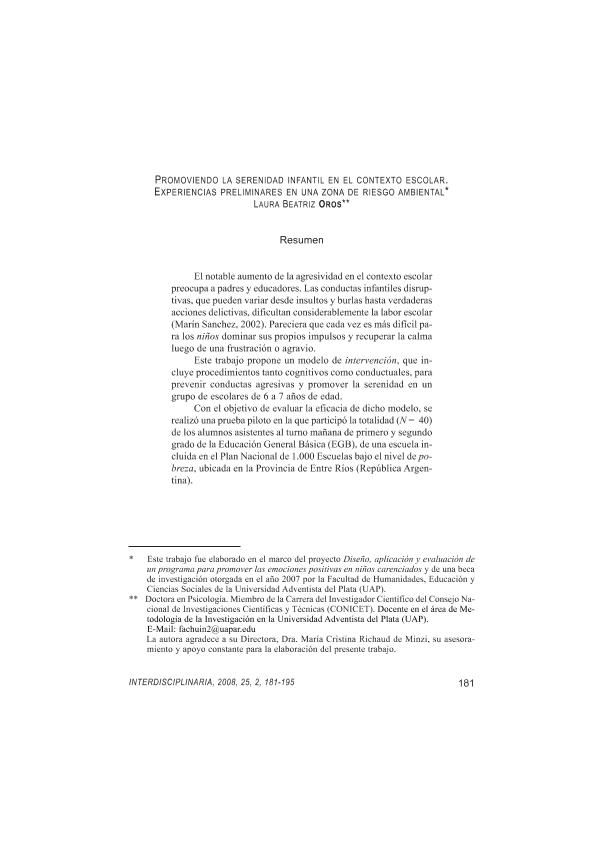Mostrar el registro sencillo del ítem
dc.contributor.author
Oros, Laura Beatriz

dc.date.available
2020-08-03T06:37:36Z
dc.date.issued
2008-12
dc.identifier.citation
Oros, Laura Beatriz; Promoviendo la serenidad infantil en el contexto escolar. experiencias preliminares en una zona de riesgo ambiental; Centro Interamericano de Investigaciones Psicológicas y Ciencias Afines; Interdisciplinaria; 25; 2; 12-2008; 181-195
dc.identifier.issn
0325-8203
dc.identifier.uri
http://hdl.handle.net/11336/110726
dc.description.abstract
El notable aumento de la agresividad en el contexto escolar preocupa a padres y educadores. Las conductas infantiles disruptivas, que pueden variar desde insultos y burlas hasta verdaderas acciones delictivas, dificultan considerablemente la labor escolar (Marín Sanchez, 2002). Pareciera que cada vez es más difícil para los niños dominar sus propios impulsos y recuperar la calma luego de una frustración o agravio. Este trabajo propone un modelo de intervención, que incluye procedimientos tanto cognitivos como conductuales, para prevenir conductas agresivas y promover la serenidad en un grupo de escolares de entre 6 y 7 años de edad. Con el objetivo de evaluar la eficacia de dicho modelo, se realizó una prueba piloto en la que participó la totalidad (n = 40) de los alumnos asistentes al turno mañana de primero y segundo grado de la Educación General Básica (EGB), de una escuela incluida en el Plan Nacional de 1.000 escuelas bajo el nivel de pobreza, ubicada en la Provincia de Entre Ríos (República Argentina). Se realizaron entrevistas personales pre y post intervención con el objeto de evaluar con qué tipo de conductas los niños intentaban disipar la ansiedad, el enojo o la frustración. Se realizó un análisis de contenido para analizar el material discursivo recogido mediante las entrevistas y se emplearon pruebas cuantitativas para analizar si se habían producido cambios en las reacciones de los niños como consecuencia de la intervención. Los resultados indican una reducción significativa de las conductas disruptivas luego de la aplicación del modelo de relajación y una adquisición progresiva de respuestas más adaptativas frente a situaciones de estrés interpersonal.
dc.description.abstract
Parents and educators alike are concerned as a result of a significant increase in aggressive behaviors in school. Disruptive behaviors in children, which can go from making fun and bullying a classmate to real criminal behavior, make academic learning processes more difficult (Marín Sanchez, 2002). Apparently, it seems more difficult for children to control their impulses and regain calmness after an event of frustration or offense. This paper suggests an intervention model that includes both cognitive and behavioral procedures, so as to prevent aggressive behavior and foster calmness in a group of 6 to 7-year old school children. In order to assess the effectiveness of the model proposed, a pilot study was applied to the totality (N = 40) of children attending grades first and second of a elementary school included in the Federal Plan for 1,000 Schools in poverty level, in the Province of Entre Ríos (República Argentina). Personal interviews were carried out before and after the intervention so as to assess whether before a stressful event children had developed the ability of relaxing through their use of an adaptive strategy or, on the contrary, showed hasty reactions, as evidence of lack of control in their impulses and emotions. The intervention strategies were implemented within the classroom. Their teachers acted as overseers and qualified professionals acted as observers, writing down the students' difficulties and achievements, so as to make adjustments in the program according to the needs of every group. Both professionals had been previously trained in both the theoretical and practical aspects of intervention. The program included six 45-minute sessions. Both cognitive and behavioral procedures were used. Strategies of intervention included, among others, modelling, positive reinforcing, mental and physical relaxation techniques, breathing training, behavioral practice, cost-benefits analysis, search for alternatives, self-referential techniques, narrations, and planned games. Every session was closed with a generalization assignment, in order to transfer what had been learnt to other significant contexts (home, neighborhood, etc.). A content analysis was made to analyze the discourse findings collected at the time of the interviews and quantitative tests were applied in order to find out whether changes in behavior had been produced after the intervention. Results show a significant reduction in disruptive behaviors after applying the relaxation model and a progressive acquisition of more adapted answers in interpersonal stress events (V = .37; p = .002). The first assessment showed near 20 percent of clearly violent reactions as a means of solving problems or relieving tensions ("I punch him", "I hit the wall", "I kick him back", etc.); in the second assessment, however, it went down to 11 percent. On the other hand, in the first assessment not a single child mentioned specific attempts of relaxing or calming down before answering to an insult or an aggression episode, but in the second one, 43 percent of answers included this category ("I breathe deeply", "I count up to three first", etc.). Moreover, it was encouraging to find that some children not only made good use of the techniques suggested by the team, but also developed the ability of thinking in new ways of relaxing, which were applied according to their own needs and preferences.
dc.format
application/pdf
dc.language.iso
spa
dc.publisher
Centro Interamericano de Investigaciones Psicológicas y Ciencias Afines
dc.rights
info:eu-repo/semantics/openAccess
dc.rights.uri
https://creativecommons.org/licenses/by-nc/2.5/ar/
dc.subject
AGRESIÒN
dc.subject
NIÑOS
dc.subject
POBREZA
dc.subject
RELAJACIÒN
dc.subject.classification
Psicología especial

dc.subject.classification
Psicología

dc.subject.classification
CIENCIAS SOCIALES

dc.title
Promoviendo la serenidad infantil en el contexto escolar. experiencias preliminares en una zona de riesgo ambiental
dc.title
Promoting calmness in school children: preliminary experiences in an environmentally at-risk setting
dc.type
info:eu-repo/semantics/article
dc.type
info:ar-repo/semantics/artículo
dc.type
info:eu-repo/semantics/publishedVersion
dc.date.updated
2020-07-21T20:24:01Z
dc.identifier.eissn
1668-7027
dc.journal.volume
25
dc.journal.number
2
dc.journal.pagination
181-195
dc.journal.pais
Argentina

dc.journal.ciudad
Ciudad Autónoma de Buenos Aires
dc.description.fil
Fil: Oros, Laura Beatriz. Consejo Nacional de Investigaciones Científicas y Técnicas. Oficina de Coordinación Administrativa Saavedra 15. Centro Interdisciplinario de Investigaciones en Psicología Matemática y Experimental "Dr. Horacio J. A. Rimoldi". Grupo Vinculado CIIPME - Entre Ríos - Centro Interdisciplinario de Investigaciones en Psicología Matemática y Experimental "Dr. Horacio J. A. Rimoldi"; Argentina
dc.journal.title
Interdisciplinaria
dc.relation.alternativeid
info:eu-repo/semantics/altIdentifier/url/http://www.scielo.org.ar/pdf/interd/v25n2/v25n2a02.pdf
Archivos asociados
